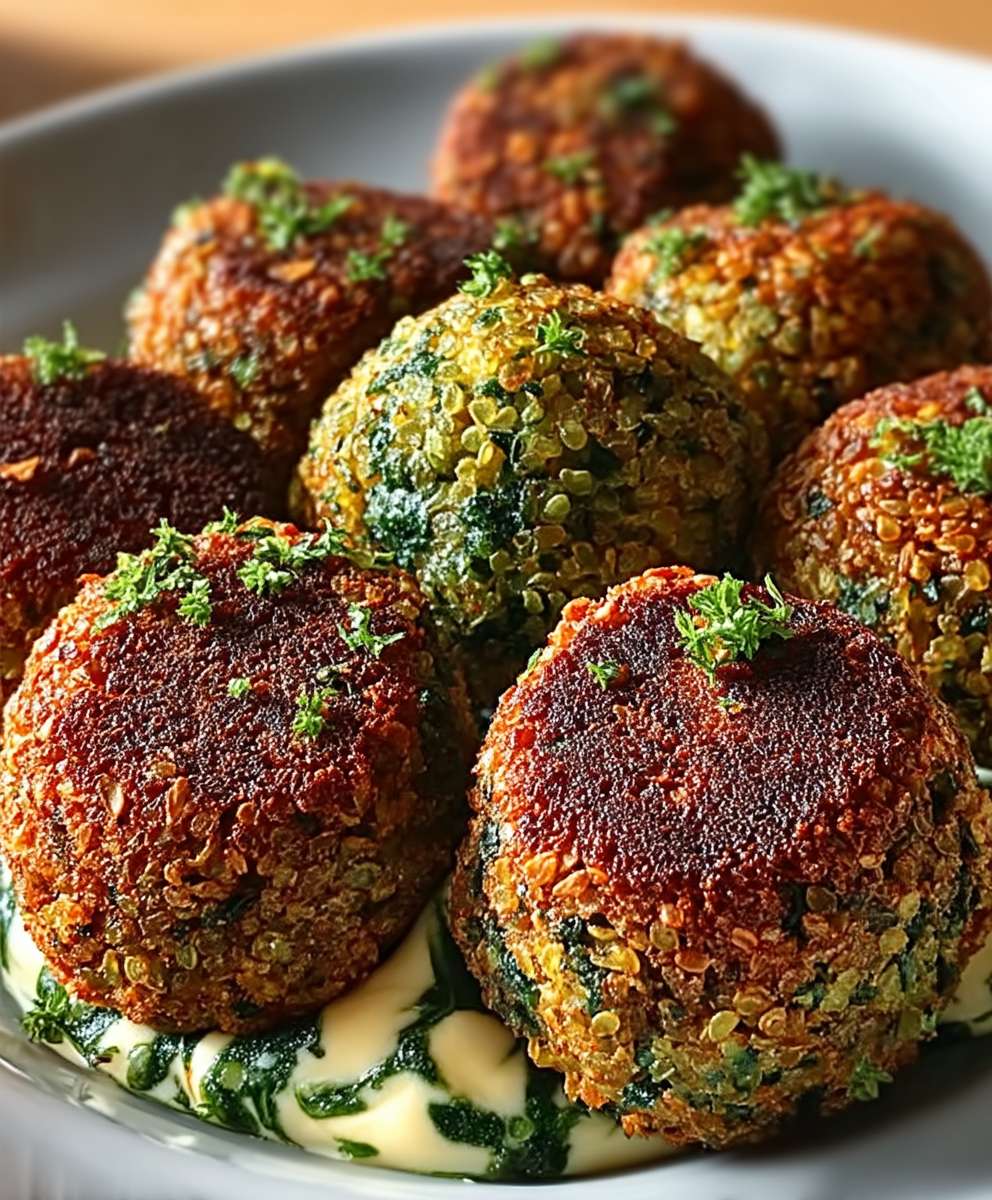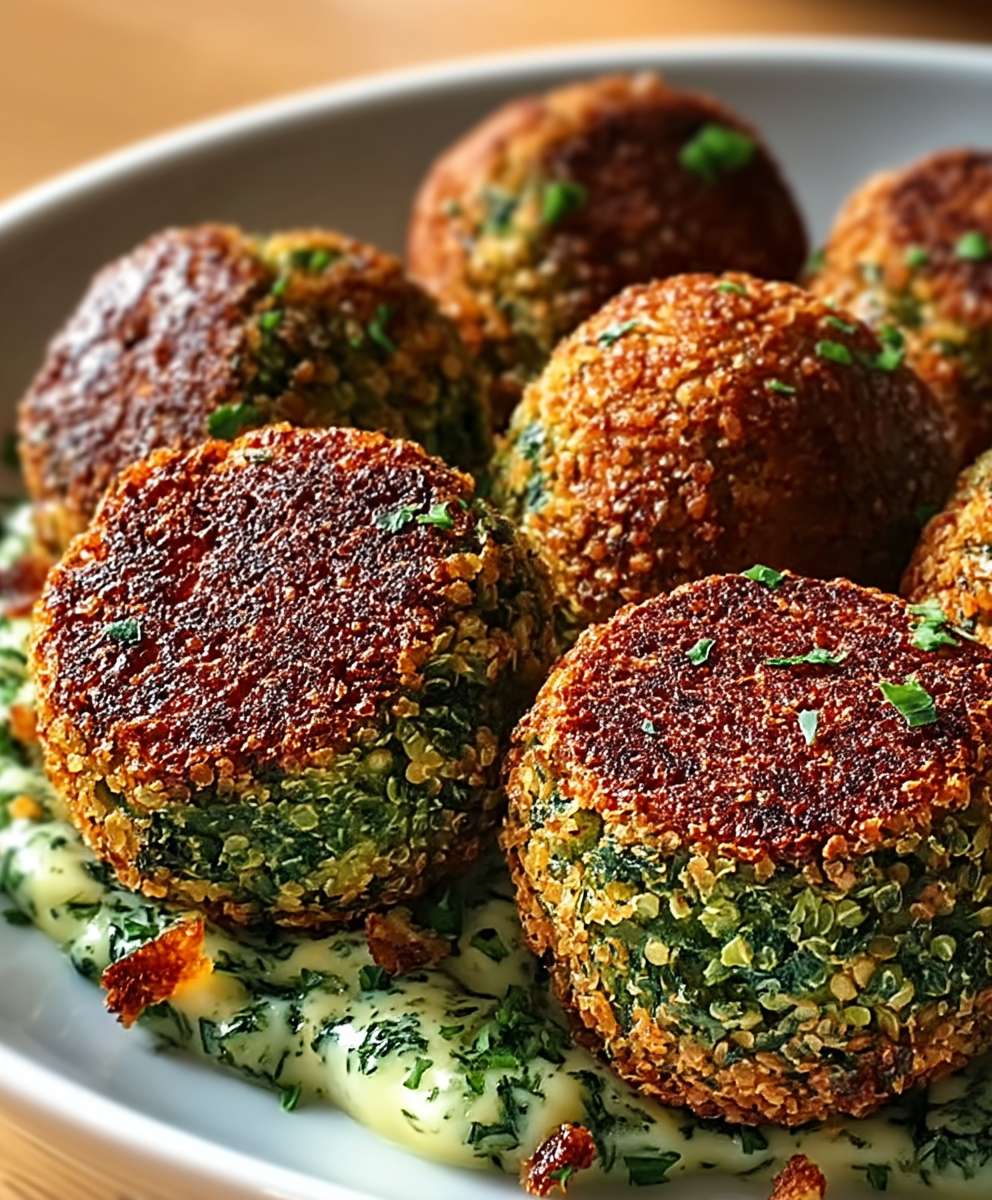Authentic Homemade Falafel, those crispy, golden-brown orbs of deliciousness, are calling your name! Forget the dry, crumbly versions you might have encountered; we’re about to embark on a culinary journey to create falafel so flavorful and perfectly textured, you’ll never look at store-bought again. Imagine biting into a warm, freshly fried falafel, the crunchy exterior giving way to a soft, herbaceous interior a symphony of flavors that will transport you straight to the heart of the Middle East.
Falafel’s history is as rich and complex as its flavor profile. While its exact origins are debated, many believe it originated in Egypt, where it was made with fava beans. Over time, the recipe evolved, and chickpeas became the star ingredient, spreading throughout the Middle East and eventually captivating the world. This humble street food has become a symbol of Middle Eastern cuisine, enjoyed by people of all backgrounds.
What makes authentic homemade falafel so irresistible? It’s the perfect combination of textures and tastes. The crispy exterior provides a satisfying crunch, while the interior is soft, moist, and bursting with fresh herbs and spices. Its also incredibly versatile! Enjoy it in a pita with hummus, tahini, and your favorite veggies, or serve it as part of a mezze platter. Plus, making it from scratch allows you to control the ingredients and customize the flavors to your liking. So, are you ready to ditch the store-bought stuff and experience the joy of truly authentic falafel? Let’s get started!
Ingredients:
- 1 pound dried chickpeas, not canned (very important!)
- 1 medium onion, roughly chopped
- 4 cloves garlic, minced
- 1/2 cup packed fresh parsley
- 1/4 cup packed fresh cilantro
- 2 tablespoons all-purpose flour (or chickpea flour for gluten-free)
- 1 tablespoon ground cumin
- 1 tablespoon ground coriander
- 1 teaspoon baking powder
- 1/2 teaspoon cayenne pepper (optional, for a little kick)
- 1 teaspoon salt, or to taste
- 1/2 teaspoon black pepper, or to taste
- Vegetable oil, for frying (canola, sunflower, or peanut oil work well)
- Pita bread, for serving
- Toppings of your choice: hummus, tahini sauce, Israeli salad, pickles, hot sauce, etc.
Soaking the Chickpeas: The Foundation of Great Falafel
Okay, let’s get started! The most crucial step in making authentic falafel is using dried chickpeas. Canned chickpeas just won’t cut it; they’re too soft and will result in a mushy falafel that falls apart in the oil. Trust me, I’ve tried it, and it’s not pretty. So, plan ahead and soak those chickpeas!
- Rinse the chickpeas: Place the dried chickpeas in a large bowl and rinse them thoroughly under cold water. Pick out any debris or shriveled chickpeas.
- Soak in plenty of water: Cover the chickpeas with plenty of cold water at least 2-3 inches above the chickpeas. They will expand significantly as they soak.
- Soaking time: Let the chickpeas soak for at least 12-24 hours at room temperature. Change the water a couple of times during the soaking process. This helps to remove some of the phytic acid, making them easier to digest.
- Check for readiness: The chickpeas are ready when they are plump and easily pierced with a fingernail. If they’re still hard, soak them for a few more hours.
- Drain and rinse: Once soaked, drain the chickpeas completely and rinse them well under cold water.
Preparing the Falafel Mixture: The Heart of the Recipe
Now that our chickpeas are perfectly soaked, we can move on to creating the falafel mixture. This is where the magic happens, and the fragrant spices come together to create that classic falafel flavor.
- Combine ingredients in a food processor: In a food processor, combine the soaked and drained chickpeas, onion, garlic, parsley, and cilantro.
- Process until coarsely ground: Pulse the food processor until the mixture is coarsely ground. You want a slightly chunky texture, not a smooth paste. Over-processing will result in dense falafel. Scrape down the sides of the bowl as needed to ensure even processing.
- Add the dry ingredients: Add the flour (or chickpea flour), cumin, coriander, baking powder, cayenne pepper (if using), salt, and pepper to the food processor.
- Process again: Pulse the food processor until the dry ingredients are well combined and the mixture is evenly ground. Again, be careful not to over-process. The mixture should hold together when pressed between your fingers.
- Check the consistency: The mixture should be slightly damp but not wet. If it seems too wet, add a little more flour, one tablespoon at a time. If it’s too dry, add a teaspoon or two of water.
- Refrigerate the mixture: Transfer the falafel mixture to a bowl, cover it with plastic wrap, and refrigerate for at least 30 minutes, or up to 2 hours. This allows the flavors to meld together and helps the mixture to firm up, making it easier to form into balls.
Forming the Falafel: Shaping the Flavor
While the falafel mixture is chilling, you can prepare your workspace and get ready to form the falafel. This is a relatively quick process, and you can adjust the size of the falafel to your preference.
- Prepare your workspace: Line a baking sheet with parchment paper. This will prevent the falafel from sticking.
- Scoop the falafel mixture: Using a small cookie scoop or a spoon, scoop out portions of the falafel mixture. Aim for about 1-2 tablespoons per falafel.
- Shape into balls or patties: Gently roll each portion into a ball or flatten it into a small patty. The shape is up to you! I personally prefer slightly flattened patties, as they cook more evenly.
- Place on the prepared baking sheet: Place the formed falafel on the prepared baking sheet, leaving a little space between each one.
Frying the Falafel: Achieving Golden Perfection
Now for the exciting part frying the falafel! This is where they transform from humble chickpea balls into crispy, golden-brown delights. It’s important to maintain the correct oil temperature to ensure they cook evenly and don’t absorb too much oil.
- Heat the oil: Pour about 2-3 inches of vegetable oil into a deep pot or Dutch oven. Heat the oil over medium-high heat until it reaches 350-375°F (175-190°C). Use a deep-fry thermometer to monitor the temperature. If you don’t have a thermometer, you can test the oil by dropping a small piece of falafel into it. If it sizzles and turns golden brown in about 1-2 minutes, the oil is ready.
- Fry in batches: Carefully add the falafel to the hot oil in batches, being careful not to overcrowd the pot. Overcrowding will lower the oil temperature and result in soggy falafel.
- Fry until golden brown: Fry the falafel for about 3-5 minutes per side, or until they are golden brown and crispy. Turn them occasionally to ensure even cooking.
- Remove and drain: Use a slotted spoon or spider to remove the falafel from the oil and place them on a wire rack lined with paper towels to drain excess oil.
Serving the Falafel: The Grand Finale
Congratulations, you’ve made authentic homemade falafel! Now it’s time to enjoy the fruits of your labor. There are countless ways to serve falafel, but here are a few of my favorites:
- In pita bread: This is the classic way to serve falafel. Warm some pita bread and stuff it with falafel, hummus, tahini sauce, Israeli salad, pickles, and hot sauce.
- As a salad topping: Add falafel to your favorite salad for a protein-packed and flavorful boost.
- As a side dish: Serve falafel as a side dish with a variety of dips and sauces.
- On a platter: Create a beautiful platter with falafel, hummus, baba ghanoush, pita bread, and various toppings for a Middle Eastern feast.
Tips for Perfect Falafel:
- Don’t use canned chickpeas: I can’t stress this enough! Dried chickpeas are essential for the right texture.
- Don’t over-process the mixture: A slightly chunky texture is key to avoiding dense falafel.
- Refrigerate the mixture: This allows the flavors to meld and helps the falafel hold their shape.
- Maintain the correct oil temperature: This ensures even cooking and prevents soggy falafel.
- Don’t overcrowd the pot: Fry the falafel in batches to maintain the oil temperature.
Variations:
- Add spices: Experiment with different spices, such as smoked paprika, turmeric, or chili powder.
- Add herbs: Try adding different herbs, such as mint or dill.
- Make it gluten-free: Use chickpea flour instead of all-purpose flour.
- Bake the falafel: For a healthier option, you can bake the falafel instead of frying them. Preheat your oven to 375°F (190°C) and bake for 20-25 minutes, or until golden brown.
Enjoy your delicious, homemade falafel! I hope you found this recipe helpful and that you’ll try it out soon. Let me know in the comments how it turns out!

Conclusion:
This isn’t just another falafel recipe; it’s your passport to experiencing authentic homemade falafel bursting with fresh, vibrant flavors. From the satisfying crunch of the exterior to the tender, herbaceous interior, every bite is a testament to the power of simple, quality ingredients. I truly believe this recipe will become a staple in your kitchen, not just because it’s delicious, but because it’s surprisingly easy to make once you get the hang of it.
Why is this a must-try? Because it’s so much better than anything you can buy pre-made or from most restaurants! You control the ingredients, ensuring freshness and avoiding any unwanted additives. Plus, the process of making it yourself is incredibly rewarding. There’s something deeply satisfying about transforming dried chickpeas into these golden-brown orbs of deliciousness. And let’s be honest, the aroma that fills your kitchen while they’re frying is simply irresistible!
But the best part? The versatility! While these falafel are fantastic served in warm pita bread with hummus, tahini, and all your favorite toppings like chopped tomatoes, cucumbers, and pickled turnips, the possibilities don’t end there.
Serving Suggestions and Variations:
* Falafel Salad: Crumble the falafel over a bed of mixed greens with a lemon-tahini dressing for a light and refreshing lunch. Add some roasted vegetables like bell peppers and eggplant for extra flavor and texture.
* Falafel Bowls: Build your own falafel bowl with a base of quinoa or brown rice, topped with falafel, roasted vegetables, a dollop of Greek yogurt, and a drizzle of sriracha.
* Falafel Burgers: Flatten the falafel mixture into patties and pan-fry or bake them for a healthier alternative to traditional burgers. Serve on a bun with your favorite burger toppings.
* Spicy Falafel: Add a pinch of cayenne pepper or a finely chopped jalapeño to the falafel mixture for a kick of heat.
* Herbaceous Falafel: Experiment with different herbs like cilantro, parsley, or mint to create your own unique flavor profile.
* Baked Falafel: For a healthier option, bake the falafel instead of frying. Preheat your oven to 375°F (190°C), lightly brush the falafel with olive oil, and bake for 20-25 minutes, or until golden brown. They won’t be quite as crispy as the fried version, but they’ll still be delicious!
* Falafel with different beans: While this recipe is for authentic chickpea falafel, you can experiment with other beans like fava beans for a different flavor profile.
I truly encourage you to give this recipe a try. Don’t be intimidated by the soaking process; it’s essential for achieving the right texture. And don’t be afraid to experiment with different spices and herbs to create your own signature falafel.
Once you’ve made your own batch of authentic homemade falafel, I’d love to hear about your experience! Did you try any of the variations? What toppings did you use? Share your photos and comments below I can’t wait to see what you create! Happy cooking! I am confident that you will enjoy this recipe as much as I do. It’s a labor of love, but the results are well worth the effort. Enjoy!
Authentic Homemade Falafel: The Ultimate Recipe and Guide
Crispy, golden falafel made from scratch with soaked chickpeas, fresh herbs, and spices. Authentic Middle Eastern flavor!
Ingredients
- 1 pound dried chickpeas, not canned
- 1 medium onion, roughly chopped
- 4 cloves garlic, minced
- 1/2 cup packed fresh parsley
- 1/4 cup packed fresh cilantro
- 2 tablespoons all-purpose flour (or chickpea flour for gluten-free)
- 1 tablespoon ground cumin
- 1 tablespoon ground coriander
- 1 teaspoon baking powder
- 1/2 teaspoon cayenne pepper (optional, for a little kick)
- 1 teaspoon salt, or to taste
- 1/2 teaspoon black pepper, or to taste
- Vegetable oil, for frying (canola, sunflower, or peanut oil work well)
- Pita bread, for serving
- Toppings of your choice: hummus, tahini sauce, Israeli salad, pickles, hot sauce, etc.
Instructions
- Soak the Chickpeas: Rinse dried chickpeas and soak in plenty of cold water for 12-24 hours, changing the water a couple of times. Drain and rinse well.
- Prepare the Falafel Mixture: In a food processor, combine soaked chickpeas, onion, garlic, parsley, and cilantro. Pulse until coarsely ground.
- Add flour (or chickpea flour), cumin, coriander, baking powder, cayenne pepper (if using), salt, and pepper. Pulse until well combined, being careful not to over-process.
- Check consistency: If too wet, add more flour; if too dry, add a little water.
- Refrigerate the mixture for at least 30 minutes, or up to 2 hours.
- Form the Falafel: Line a baking sheet with parchment paper. Scoop the falafel mixture and shape into balls or patties. Place on the prepared baking sheet.
- Fry the Falafel: Heat 2-3 inches of vegetable oil in a deep pot to 350-375°F (175-190°C).
- Fry falafel in batches for 3-5 minutes per side, until golden brown and crispy. Turn occasionally.
- Remove and drain on a wire rack lined with paper towels.
- Serve: Serve in pita bread with hummus, tahini sauce, Israeli salad, pickles, and hot sauce, or as a salad topping or side dish.
Notes
- Important: Use dried chickpeas, not canned.
- Don’t over-process the falafel mixture.
- Refrigerating the mixture helps the flavors meld and the falafel hold their shape.
- Maintain the correct oil temperature for even cooking.
- Fry in batches to avoid overcrowding the pot.
- Variations: Add different spices or herbs. Use chickpea flour for gluten-free. Bake for a healthier option.

